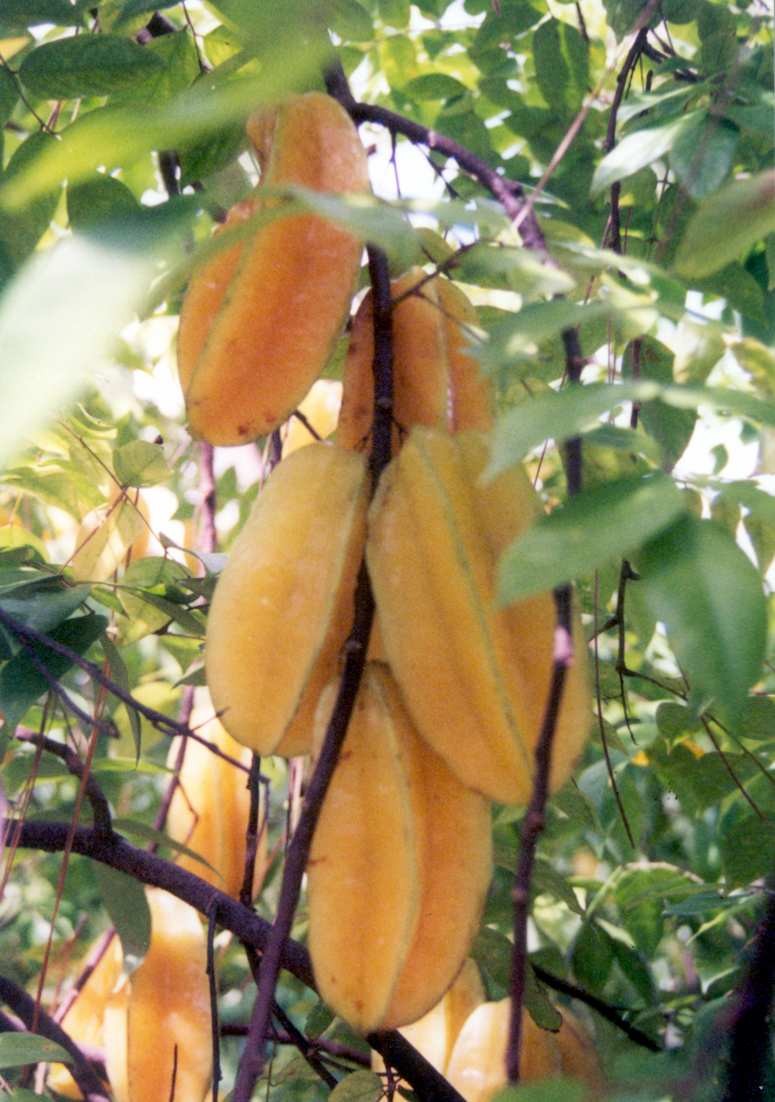Star fruit or Carambola (Averrhoa carambola L.) is one of my favorite tropical fruits. My children love to pick these fresh off the trees and eat the delicious and nutritious fruit, which does not need to be peeled or seeded. It makes a great dooryard tree. The trees bear prolifically (up to 250 lbs of fruit a year), but do not get very tall so the fruits are easy to reach. The fruit gets its name from the five-pointed star shape that is seen when it is cut across the middle. When ripe, it is a golden yellow and has a smooth waxy surface. It is an excellent source of vitamin C, with one fruit providing 45% of the Recommended Daily Value. Carambola is an excellent fruit to grow in the tropics because it has prolific fruit production, high nutrition, almost continuous fruiting, wide appeal and is very adaptable to different soils and locations. Most amazingly, it bears fruit only 2-3 years after planting from seed! It bears 6-8 months out of the year, sometimes even 12 months in the wet tropics. Carambola has great potential in improving nutrition and income in many communities. The carambola is originally from Sri Lanka and the Moluccas and is widely cultivated in Southeast Asia. It is also called bilimbi, Chinese star fruit and star apple. Today it is also cultivated in Africa and the Americas. It is a handsome, slow growing tree that seldom exceeds 25-30 feet in height. Its canopy is broad and round. The carambola is classified as a tropical tree although mature trees can tolerate temperatures as low as 27ºF (-2.8ºC) for short periods of time. Young trees need to be protected from cold wind.
Although it can grow in many different kinds of soil, it does best in rich loam. It is harmed by waterlogged soil and its leaves start to yellow in alkaline soil. The tree needs ample moisture for the best growth. Because it is a small tree, you can protect it from frost. A spacing of 20 ft is recommended for plantings. It grows at up to 4000 ft. elevations. Pruning by cutting the terminal ends of the branch can extend production, and removing all leaves and lateral shoots can induce off-season flowering. There are no serious pests or diseases except for fruit flies. The carambola can be grown from seeds but the seeds are viable for only a few weeks and viability declines steadily. Plant only fully developed seeds.
Trees from seeds will show a wide variation in fruit color and sweetness. You should graft sweet varieties to seedling root- stocks. Chip-budding is a method used in Florida nurseries: buds are collected from ¼ inch diameter wood and grafted to root-stocks of the same diameter. In veneer grafting, healthy year-old seedlings ¾ inch in diameter are best for root-stocks. Graft wood is taken from mature twigs with leaves present and with some buds. Cleft grafting of green bud-wood can also be used. The length of time until the first crop is about 2-3 years from seed.

The fruit ranges from tart to sweet. There may be 6-12 flat seeds in each fruit. The fruit is best ripened on the tree but can be picked green to ripen on the shelf. You may want to trim each rib and remove the darker green edge, which can be bitter. It has a slight oxalic acid flavor. The carambola fruits can be easily damaged so care must be taken in packaging and storing. They can be stored at room temperature for two to three days and refrigerated in a bag for up to a week. Fruit can be eaten as part of a salad; used in chutney, tarts, and preserves; or dried. Slightly under ripe fruit can be used in pickling or jams. Carambola makes a refreshing beverage. In China it is made into a sour juice that is used to help relieve sore throats. Our ECHO interns have made carambola breads, muffins and a delicious star fruit “upside down cake”!
There are several varieties of carambolas. Our seed bank has seed available from Arkin, Sri Kembangum, Bell and Kary varieties. Since these seeds do not come true to seed, after the trees bear fruit you should select the ones with sweeter fruit to be propagated by grafting. Seeds should be planted as soon as they are received. With the potential of one tree producing up to 250 pounds of fruit per year, this fruit is truly a star! Give the tree lots of sun, moisture and rich soil and it will give you lots of tropical delights
Cite as:
Ju, G. 2004. Carambola—A Five Star Fruit. ECHO Development Notes no. 85